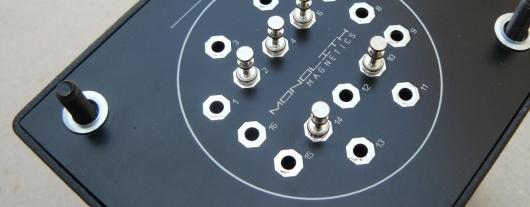
Our knowledge is based on extensive research in the domain of audio transformers and electromagnetics in general. Our philosophy is to use mathematical models and a simulation model developed in-house to tailor the characteristics of our products.
All products are tested extensively technically and auditively and we take pride in manufacturing products with the highest degree of craftsmanship.
The company
MONOLITH MAGNETICS is the result of a cooperation between Dr. Ward De Ceuninck and Yves Pexsters, two men sharing a passion for music and the technology involved in its reproduction. Office and production facilities are located in Belgium, EU.
Synthesis of our research, a computer aided design model
The urge to re-explore historical knowledge on audio transformers was originally a purely academic passion without a commercial product in mind. The idea of a commercial challenge came in a natural way during the research process.

Whilst already having substantial knowledge on electro-magnetics, physics in general and practical transformer design and manufacture, a full 3 years were spent on research, the time required to build a useful computer model that could simulate and optimize a wideband transformer on the drawing board.
This research process involved a series of over 80 prototype transformers with the purpose of investigating specific phenomena, comparing field data with the simulation in order to fine-tune and calibrate the model.
The recorded measurements and gathered insights have enabled us to develop a computer aided mathematical/physical model that has been refined ever since and will be in future. This model can be seen as simulation software that takes into account any design parameter relevant to a wideband transformer, be it :
 A material property of magnet wire, magnetic core material and insulation dielectric data
A material property of magnet wire, magnetic core material and insulation dielectric data A physical distance inside the core, coil and windings geometry
A physical distance inside the core, coil and windings geometry An input/output electrical data like levels, frequencies, source impedance and load properties.
An input/output electrical data like levels, frequencies, source impedance and load properties.
It gives a clear view on what can be described as parasitic phenomena, the unwanted extras that turn the theoretically perfect transformer into the real life transformer with its shortcomings like insertion loss, leakage flux and waveform distortion.

It provides a detailed analysis of the different areas in the coil geometry responsible for parasitic capacitances and much more. It shows us the consequences of changing any parameter, lets us try and evaluate the performance of any winding scheme without actually building the transformer.
Final optimisation requires not more than a few prototypes. To summarize, it assists us in what audio transformer design is all about: “The art of making an excellent compromise”
